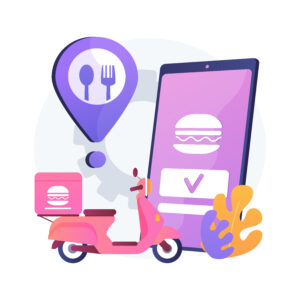
The food delivery industry has witnessed exponential growth, with apps like Uber Eats leading the charge in the United States and globally. If you’re looking to build a similar platform, understanding the technical architecture, features, and development process is crucial. This comprehensive guide will walk you through everything you need to know about creating a successful food delivery app.
Understanding the Uber Eats Business Model
Before diving into development, it’s essential to understand how Uber Eats operates. The platform connects three key stakeholders: customers, restaurants, and delivery partners. Each group interacts with the platform differently, requiring separate interfaces and functionalities.
Uber Eats generates revenue through multiple streams including restaurant commissions (typically 15-30%), delivery fees, service fees, advertising, and premium subscriptions like Uber One. This multi-faceted approach ensures sustainable growth and profitability.
Essential Features for Your Food Delivery App
Customer App Features
User Registration & Profiles: Allow users to sign up using email, phone numbers, or social media accounts. Profile management should include saved addresses, payment methods, and order history.
Restaurant Discovery: Implement advanced search and filtering options based on cuisine type, ratings, price range, and delivery time. Integration of location-based services helps users find nearby restaurants.
Menu Browsing: Display detailed menus with high-quality images, descriptions, pricing, and customization options. Include dietary information and allergen warnings.
Order Placement: Create a seamless ordering flow with real-time cart updates, special instructions, and multiple payment options including cards, wallets, and digital payments.
Real-Time Tracking: GPS-enabled tracking allows customers to monitor their order from preparation to delivery. Push notifications keep users informed at every stage.
Ratings & Reviews: Enable customers to rate restaurants and delivery experiences, building trust and helping others make informed decisions.
Restaurant Partner Dashboard
Order Management: Restaurants need a streamlined interface to receive, accept, and manage incoming orders efficiently.
Menu Management: Allow restaurant owners to update menus, pricing, availability, and special offers in real-time.
Analytics Dashboard: Provide insights on sales, popular items, peak hours, and customer feedback to help restaurants optimize operations.
Payment Tracking: Transparent financial reporting showing earnings, commissions, and payout schedules.
Delivery Partner App
Order Assignment: Smart algorithms should assign orders based on proximity, availability, and efficiency.
Navigation: Integrated GPS navigation to guide delivery partners to restaurant and customer locations.
Earnings Tracker: Clear visibility of completed deliveries, earnings, and incentives.
Availability Management: Allow delivery partners to toggle availability and manage their working hours.
Technology Stack for Building Your App
Frontend Development
For mobile apps, consider native development using Swift for iOS and Kotlin for Android, or cross-platform frameworks like React Native or Flutter for cost-effectiveness and faster development cycles.
For the web platform, modern JavaScript frameworks like React.js, Vue.js, or Angular provide responsive and dynamic user interfaces.
Backend Development
Choose robust backend technologies like Node.js, Python (Django/Flask), Ruby on Rails, or Java Spring Boot. Your backend should handle authentication, business logic, database operations, and third-party integrations.
Database Selection
Use a combination of SQL databases (PostgreSQL, MySQL) for transactional data and NoSQL databases (MongoDB, Cassandra) for flexible, scalable data storage. Redis can be implemented for caching frequently accessed data.
Cloud Infrastructure
Deploy your application on reliable cloud platforms like AWS, Google Cloud, or Microsoft Azure. These provide scalability, security, and various managed services that reduce development overhead.
Essential Integrations
- Payment Gateways: Stripe, PayPal, Braintree, or regional payment providers
- Maps & Location: Google Maps API or Mapbox for location services
- Push Notifications: Firebase Cloud Messaging or OneSignal
- SMS & Email: Twilio for SMS, SendGrid for email communications
- Analytics: Google Analytics, Mixpanel, or Amplitude
Development Process: Step-by-Step
1. Market Research & Planning
Conduct thorough market analysis to identify your target audience, competitors, and unique value proposition. Define your business model, revenue streams, and growth strategy.
2. Design Phase
Create wireframes and prototypes focusing on user experience. Design should prioritize simplicity, intuitive navigation, and visual appeal. Conduct usability testing with potential users to refine the interface.
3. MVP Development
Start with a Minimum Viable Product containing core features: user registration, restaurant listings, ordering, payment processing, and basic tracking. This allows you to launch quickly and gather real user feedback.
4. Testing
Implement comprehensive testing strategies including unit testing, integration testing, performance testing, and security testing. Beta testing with real users helps identify issues before full launch.
5. Launch & Marketing
Deploy your app on iOS App Store and Google Play Store. Develop a marketing strategy encompassing social media, content marketing, partnerships with restaurants, and promotional campaigns.
6. Continuous Improvement
Post-launch, monitor user behavior through analytics, gather feedback, and regularly update the app with new features, performance improvements, and bug fixes.
Advanced Features to Differentiate Your App
AI-Powered Recommendations: Machine learning algorithms can suggest restaurants and dishes based on user preferences and order history.
Scheduled Ordering: Allow users to place orders in advance for specific delivery times.
Group Ordering: Enable multiple users to add items to a single order for office lunches or parties.
Subscription Plans: Offer premium memberships with benefits like free delivery, exclusive discounts, or priority support (similar to Uber One).
Live Chat Support: Implement real-time customer support to resolve issues quickly and improve satisfaction.
Loyalty Programs: Reward frequent users with points, cashback, or special offers to encourage retention.
Multi-Restaurant Orders: Allow customers to order from multiple restaurants in a single transaction.
Cost Considerations
Building a food delivery app involves several cost factors:
- Development: $50,000 – $150,000+ depending on complexity and team location
- Design: $10,000 – $30,000 for comprehensive UI/UX design
- Infrastructure: $500 – $5,000+ monthly for cloud hosting and services
- Marketing: Variable budget for user acquisition and brand building
- Maintenance: 15-20% of the initial development cost annually
Challenges You’ll Face
Competition: The market is dominated by established players like Uber Eats, DoorDash, and Grubhub with significant resources and user bases.
Logistics Management: Coordinating restaurants, delivery partners, and customers efficiently requires sophisticated algorithms and operations.
Quality Control: Maintaining food quality and timely delivery is crucial for customer satisfaction.
Regulatory Compliance: Navigate food safety regulations, data protection laws, and business licensing requirements.
Unit Economics: Balancing commission rates, delivery costs, and discounts while remaining profitable is challenging.
Partner with Experts for Success
Building a food delivery platform like Uber Eats requires expertise across multiple domains—from mobile development and backend architecture to UX design and cloud infrastructure. If you’re looking to transform your vision into reality, partnering with experienced developers can significantly accelerate your journey.
The right development partner brings not just technical skills but also industry insights, best practices, and a proven track record of delivering scalable applications. They can help you avoid common pitfalls, optimize your technology stack, and ensure your app meets the highest standards of performance and security.
Ready to Get Started?
Building a successful food delivery app is a complex but rewarding endeavor. With the right planning, technology choices, and execution, you can create a platform that serves your local market or scales globally.
Whether you’re at the ideation stage or ready to begin development, having the right team by your side makes all the difference. Let’s discuss your project and explore how we can help bring your food delivery app vision to life.
Conclusion
Creating an app like Uber Eats requires careful planning, robust technology, and continuous innovation. Focus on delivering exceptional user experience, ensuring reliable service, and building strong relationships with restaurant partners and delivery personnel.
The food delivery market continues to grow, particularly in the United States where apps like Uber Eats and DoorDash dominate. There’s still room for innovative platforms that address specific niches or geographic markets. With dedication, the right technology stack, and strategic execution, your food delivery app can become the next success story in this thriving industry.
Start with a clear vision, build incrementally, listen to your users, and stay adaptable to market changes. The journey of building a food delivery platform is challenging, but with persistence and the right approach, success is within reach.



